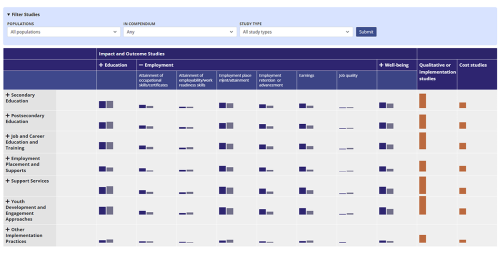An Analysis of Programs Serving Young People Not Connected to School or Work
Reconnecting Youth

Overview
The Reconnecting Youth project aims to understand systematically what programs and practices are available in the United States to support young people who experience disconnection from school and work during the transition to adulthood (typically defined as ages 16 to 24). It focuses specifically on services to help them reconnect to education, obtain employment, and advance in the labor market. This population of young people are often referred to as “disconnected youth” or “opportunity youth.”
The project, which is supported by the Office of the Assistant Secretary for Planning and Evaluation in the U.S. Department of Health and Human Services, has produced two online tools to support these goals in collaboration with Child Trends. The first is a compendium of programs the provides an overview of 78 programs and the practices they employ. The second is an evidence gap map, containing 60 studies, that looks at the available evidence about these practices to identify what evidence exists and where there are opportunities to build evidence. Each has an accompanying report to synthesize the findings from the tools.
Additional Project Details
Agenda, Scope, and Goals
This project conducted a scan of programs and practices aimed at improving education and employment outcomes for youth who are neither working nor in school—as well as studies related to programs for reconnecting youth. These efforts helped identify gaps between the programs and practices and the research that exists. The project sought to answer the following research questions:
- What programs and practices are aimed at improving education and employment outcomes for youth who are neither working nor in school?
- What is the state of the evidence on programs and practices to improve education and employment outcomes for youth who are neither working nor in school?
- What are the gaps in evidence for reconnecting youth who are neither working nor in school?
The study produced two tools: an interactive compendium of programs serving these young people and an evidence gap map, which documents and visually describes existing research about these programs and practices. The results of the program scan and evidence assessment can be used to inform future decisions about funding, coordinating, and delivering services to this population and to identify future research needs.
Design, Sites, and Data Sources
The Reconnecting Youth compendium and evidence gap map focus on programs that provide education and employment services to young people who were not working or in school and who have had experiences that put them at greater risk of long periods of disconnection from school and work, such as not having a high school credential, being parents, or having been involved with the foster care or justice system. To inform the compendium, the team gathered information on programs and practices from a variety of sources, including existing scans of the field, research and policy organizations’ websites, foundations’ websites, websites of well-known programs, clearinghouses and electronic databases, research journals, and professional conference proceedings. The team also consulted experts in the field of opportunity youth. Once the programs were determined to fit within the scope of the project, the team conducted a qualitative questionnaire to learn about program characteristics and practices. To inform the evidence gap map, the team conducted a scan of evidence from similar sources as were used for the compendium. Those studies that were determined to fit within the scope of the project were coded by the team to identify practices used, research methods employed, and outcomes measured.








